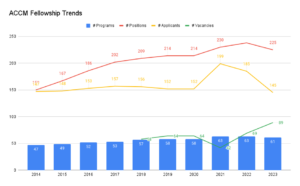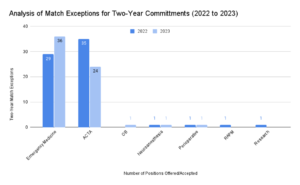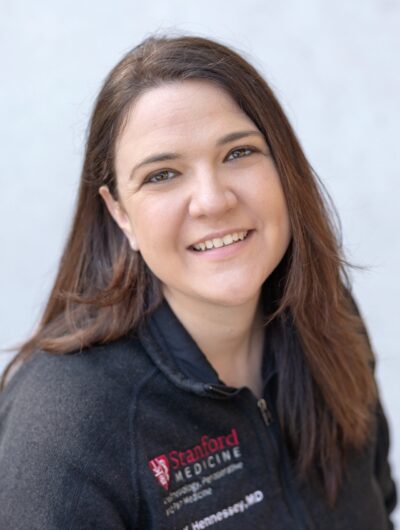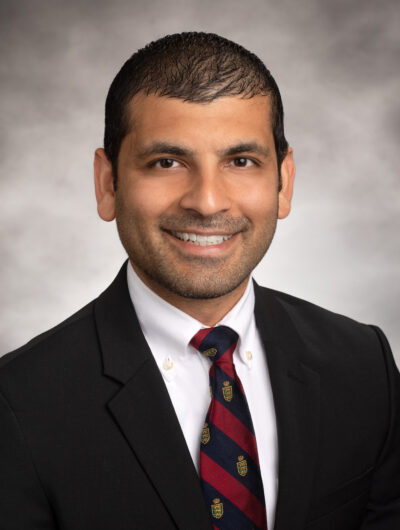The Anesthesia Critical Care Medicine Fellowship Match Remains a Buyer’s Market for the Second Year in a Row
Introduction
Anesthesia Critical Care Medicine (ACCM) is the oldest ACGME board-certified subspecialty within Anesthesiology, and similar to other subspecialty fellowship training programs, our growth has outpaced the current interest in our field. This year’s match proved again to be difficult for many programs in light of the low application numbers. With almost 40% of positions unfilled, programs are weary that the current market supply and demand curves will not become favorable in time for the upcoming 2024 match cycle. A glimpse at the trends in applicants, program expansion, and unfilled positions reveals that we should be prepared for another difficult year.

Figure 1
An interesting component of the ACCM recruitment cycle is the prospect of unique candidates securing their positions through a match exception process. The match exception process was developed to allow applicants who meet certain criteria to coordinate their training ahead of the match deadline. Overall, 60% of the ACCM positions are filled through the match exception process, and this past year, the make-up of those offers changed trajectories as well. Only 13% of candidates received exceptions to stay within their institution - a sign that applicants may be willing to move for a different or better experience in critical care training. We saw an increase in candidates from emergency medicine (who qualify for a match exception due to the need to coordinate the second year of training within the same program) and a decrease in those interested in a combined ACTA-ACCM two-year sequential training program. If these trends continue in this direction, programs will need to pivot their ability to train (and fund) emergency medicine fellows and create idealistic and inclusive training programs for one-year ACCM fellows.

Figure 2
We Remain in a Buyer’s Market
As interested applicants have started filling out their SF Match applications as of last month, the Program Director’s Advisory Council (PDAC) launched strategic projects that can be paralleled to the advice given to those selling homes in a buyer’s market. An abbreviated list of things to consider when “selling in a buyer’s market” as adapted from Zillow[1]:
- Hire an Experienced Agent
- Inspect and Make Repairs
- Update Home to Attract Buyers
- Maximize Marketing Tactics
- Offer Buyer Incentives
The PDAC convened on the sidelines of the Society of Academic Associations of Anesthesiology and Perioperative Medicine annual meeting during the critical care update session. Chaired by Dr. Erin Hennessey, the business meeting facilitated a thorough exploration of contemporary topics facing fellowship program directors, sparking significant discussions, including an in-depth discussion of the above-mentioned weary fellowship data and trends. However, the PDAC is made up of resilient, forward-thinking, and change agent intensivists, and instead of dwelling on the difficult road ahead, they jumped into specialized working groups dedicated to improving ACCM fellowship conditions across the nation in an effort to change the landscape of the current market conditions.
Hire an Experienced Agent: Investing in and Supporting Your ACCM Program Director
Dr. Hennessey's working group focused on strategies and suggestions for new program directors to succeed. Essential tips emerged, including prioritizing efforts, understanding ACGME violations, relying on program coordinators' expertise, seeking guidance from senior faculty, and building relationships with experienced program directors in the department. The group emphasized the importance of cultivating relationships with the local GME/Designated Institutional Official (DIO) and leveraging resources, best practices, and networking opportunities provided by the SOCCA PDAC group.
Inspect and Make Repairs: Updates Needed to the Fellowship Curriculum
In the evolving educational paradigm emphasizing competency-based assessments, Dr. Ameeka Pannu's working group scrutinized essential areas for a graduating fellow to master. This encompassed patient care and procedural skills, medical knowledge, practice-based learning and improvement, interpersonal and communication skills, professionalism, and systems-based practice. The group underscored the heterogeneity of critical care practices nationwide, emphasizing the importance of developing a standardized curriculum, particularly given the challenges of an increasingly complex patient population. This group is looking forward to coordinating with the SOCCA Practice Advisory Council to align fellowship training requirements with the needs of academic departments, divisions, and community practices.
Update Home to Attract Buyers: Improving Residency Rotations in ACCM
Drs. Babar Fiza and Vivek Moitra spearheaded the session on reimagining resident ICU rotations, a critical topic amid declining resident interest in critical care fellowships. The group highlighted the need to reconceptualize the structure of monthly ICU rotations, proposing innovative changes such as condensing the rotation to 2-week blocks and strategically aligning it with other rotations to alleviate demands. Discussions extended to creating opportunities for independence within the resident experience, which would foster a more insightful understanding of critical care medicine for the residents as they progress through their critical care rotations.
Maximize Marketing Tactics: Reaching Students, Residents, and Fellows
Drs. Ameeka Pannu, Allison Dalton, and Nazish Hashmi have led herculean efforts in the past to advertise programs on social media platforms. Allison Dalton, in her role of Chair of the Education Committee for SOCCA, updated the group on the importance of using the SOCCA annual meeting as a way to engage future trainees for ACCM. This year the annual meeting, in partnership with IARS, will host a large portion of critical care educational tracks and create a space for networking and engaging. Program Directors are also interested in further educational spotlights for programs and resident-focused educational products developed through SOCCA. Maximizing our exposure to trainees in addition to our colleagues in anesthesiology is important and was highlighted through panel submissions and work coordinated with the ASA.
Offer Buyer Incentives: Think Not Just Money but also Opportunities!
Many programs may have minimal control over financial specifics such as salary, educational stipends, or loan repayment options. Program Directors should think outside of the box and expand the possibilities of incentives. Unique patient care environments, wellness initiatives, mentoring, and sponsorship are all opportunities that individual programs and SOCCA PDAC can continue to develop to incentivize training in critical care. Fellowship is a one-year training program and fellows frequently are already thinking about job opportunities when interviewing for fellowship. Discussing ways to partner with both academic and private practice groups to launch their job possibilities after training helps applicants see the forest for the trees when choosing anesthesia critical care training.
Buyer’s Market, Seller’s Market, or Nobody’s Market?
The analogy of the housing market extends beyond appealing to the buyer. With a small applicant pool, program directors must still maintain the mission of their program and recruit and retain trainees that fulfill their programmatic, departmental, and institutional mission. If you recognize a resident who has the passion, drive, and compassion for critical care medicine, please encourage them to apply. This year ACCM programs will again be using the virtual interview format for recruiting and abiding by the match exception rules to facilitate a cordial and collegial environment for recruitment.
One could argue that despite over 90% of applicants getting their first choice in fellowship, a market in which we do not have enough applicants, have programs struggling to fill vacancies, and have units that remain unstaffed, is truly nobody’s market because everyone loses. Programs have the strain of trying to staff and maintain their departmental mission, trainees lose out on a full fellowship class and the camaraderie built into training with other like-minded colleagues, and patients lose when they do not have access to subspecialty, board-certified anesthesiology intensivists in hospitals across the country. The SOCCA PDAC aims to change the landscape and through motivation, compassion, and persistence, create a market where everyone gains, including our patients.
Read “The State of Anesthesia Critical Care Fellowship Programs” from Drs. Hennessey and Fiza.
[1] Umbrasas K. Selling a Home in a Buyers Market. 10.26.2019. https://www.zillow.com/learn/selling-home-in-buyers-market/





































